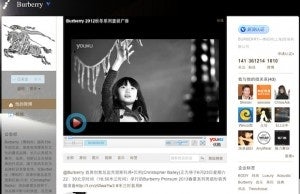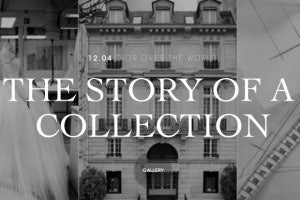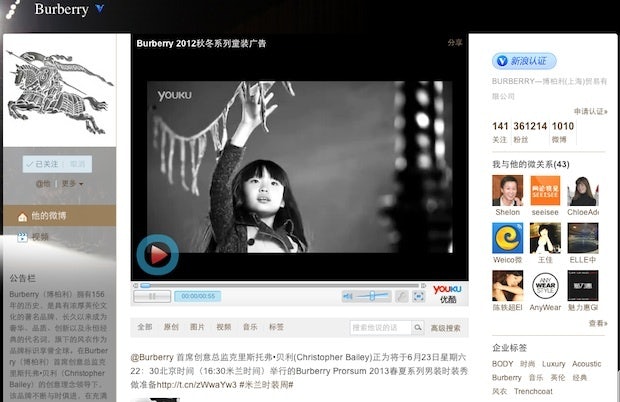"Most Luxury Brands Are Still In The Digital Stone Age"#

Luxury brands have had a love-hate relationship with new media for years, owing to the relatively "flat" nature of the medium, lack of exclusivity, and -- in developed markets where the average luxury consumer tends to be middle-aged -- the fact that it hasn't really been necessary to branch deeply into the digital world. But in China, where luxury shoppers tend to be in their 20s and 30s, digitally savvy, deal-minded and status-obsessed, the game is far different. This has become particularly true as top-tier markets like Beijing and Shanghai have become inundated with luxury flagships and malls, yet younger consumers have turned increasingly to online sources to learn more about brands, shop (via high-end e-commerce sites) and engage with brands via Twitter-like platform Sina Weibo, Foursquare-like network Jiepang, and Youtube-like video site Youku.
Of all the dynamics currently shaping the luxury digital sphere in China, perhaps none is more important than the booming e-commerce market. According to a recent study by iResearch, e-commerce transactions in China shot up 68 percent in the first quarter of this year, pushing the market to a whopping 1.8 trillion yuan (US$283 billion), with luxury e-commerce expected to exceed 20 billion yuan (US$3.1 billion). According to a report by e-commerce site Taobao, high-end e-commerce purchases in China for a full spectrum of luxury goods, including health and beauty products, surpassed 15 billion yuan (US$2.4 billion) in 2011, a 100 percent surge year-over-year. By 2015, this is expected to surge to 37.24 billion yuan (US$5.9 billion).
Turning more towards digital marketing than previous channels has been an at times uncomfortable shift for some heritage luxury brands operating in China. In many ways, digital marketing requires a tightrope walk between exclusivity and openness. This is particularly true in China, where consumers -- younger, and generally approaching luxury brands from a "blank slate" position with less established brand knowledge than consumers in Japan, South Korea, Europe or North America -- need to feel engaged with a brand to foster loyalty. But when interacting with potential buyers via "flat" platforms like Weibo, how much interaction is too much?
This week, China Daily addresses the particularities of luxury digital marketing, looking at how brands can maximize interaction while preserving exclusivity:

1. Digital is pervasive.#
Luxury brands have always been in a bind whether to use digital to become more exclusive or more accessible. But if luxury marketers grasp the full meaning of digital, they will realize it offers both and much more. Today, digital is the creative convergence of digital arts, science, technology and business for human expression, communication, social interaction and education. It has come a long way since the birth of the Internet. Digital has penetrated almost all aspects of our social and personal life. Experts have mapped this evolution from the days of monolithic websites, content creation, user participation and the birth of virtual lives to now when the digital domain has a distinct social dimension to it.
2. Digital can help engage China's younger luxury buyers.#
Most luxury brands are still in the digital Stone Age. This is not because of limited understanding of the digital world but also because most of these luxury brands were born in markets where the average luxury buyer was older and thus relatively less Net savvy. In Asia, and more specifically in China, things are a little different. In China 80 percent of wealthy consumers are under 45. Compare this with the figure for US (30 percent) and Japan (19 percent), according to the McKinsey Global Institute.
3. Digital content can give social currency.#
With more and more millionaires in town, luxury is no longer just about the price of the car or the size of the Persian carpet that one has bought - it is increasingly about the story behind the making of the object or the unique experience that it promises. As the newly rich evolve, thoughts are gaining currency over things and "experience is becoming more important than expensive".
Digital content for luxury brands needs to offer something that's worth sharing. Imagine things such as a first-hand account of space tourism or the experience of climbing virgin peaks across continents. Such stories and experiences have immense chat value and give valuable social currency to people who can access it. Similarly, digital also needs to offer content that can be shared among fans of brands who might not always own the products but aspire to it. This group provides the much-needed buzz for the brand.

4. Digital can create a community around a brand's mythology.#
Luxury brands have rich histories and heritages. Almost all successful luxury brands have rich traditions and mythologies. Similarly a luxury buyer craves a community of like-minded people. He desires to be a part of an exclusive club. Luxury brands have an important role to play here.
Add to this the fact that in countries such as China and India, with vast populations and relatively lower service standards, it is not always easy to serve the luxury buyer at a store. Digital is the missing link that can bridge this gap. While luxury offers exclusivity, digital can help provide privacy and personalization. Digital communities are a powerful way to make people feel special. In the long run such a community can also help better segment and service a brand's buyers based on their interests. These communities of ardent fans and loyalists do not just know a lot about the brand, but can play a role as brand custodians online.
5. Digital offers youthful energy (but it is different from being a youth brand).#
As luxury brands reach out to younger luxury buyers, they run the risk of mixing youthful energy with the notion of a youth brand. They need to balance youthful energy with elegance. It is important that marketers view the digital realm as a platform for the brand to listen to younger prospects and be inspired by them. This engagement can lead to valuable insights about the product designs and also help in keeping the brand relevant to future customers. Mercedes Benz did something similar when they started interacting with Generation Y in order to get feedback on vehicle designs.
